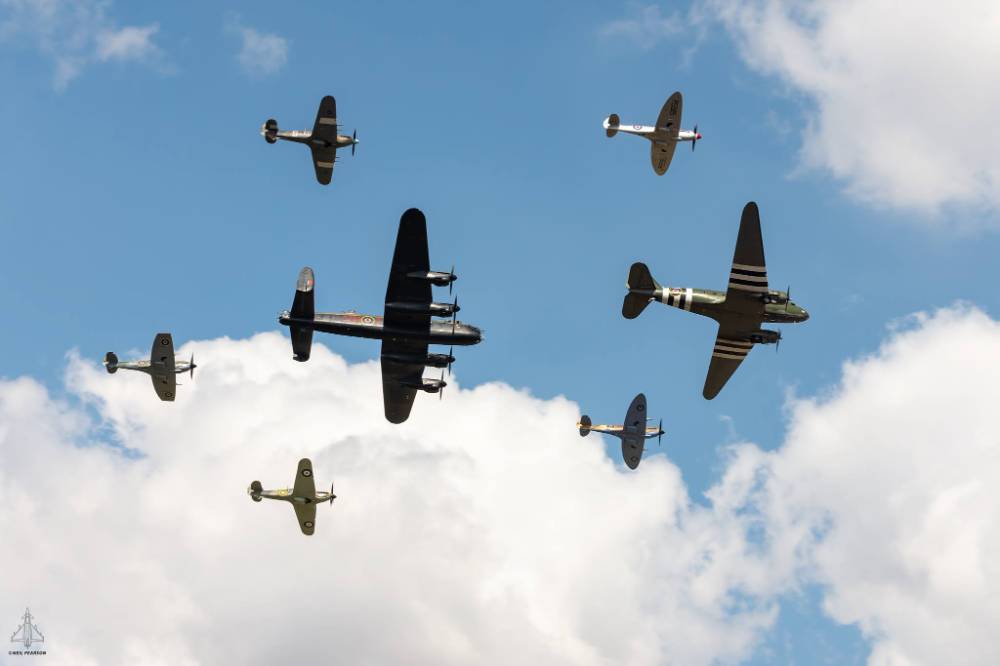
The Battle of Britain Memorial Flight. Image Courtesy of Neil Pearson
For over 60 years, the aircraft of the RAF’s Battle of Britain Memorial Flight (BBMF), based at Coningsby in Lincolnshire, have been one of the most popular air show acts in the UK and Europe. Alongside these public events, the Flight also performs numerous flypasts at occasions ranging from national commemorative events to local village fetes. Its aircraft are a living memorial, not only to the immortal ‘Few’ who were victorious in the Battle of Britain but also to the countless aircrew – and ground crew - who have given their lives in defence of the country. The Flight’s motto is ‘Lest we forget’.
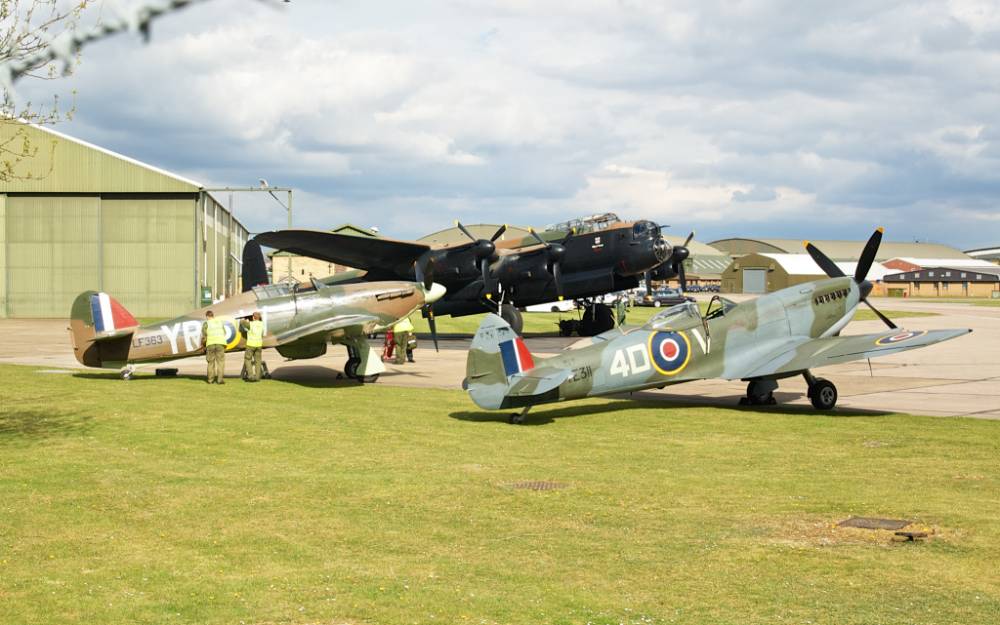
Image Courtesy of Jim Baker
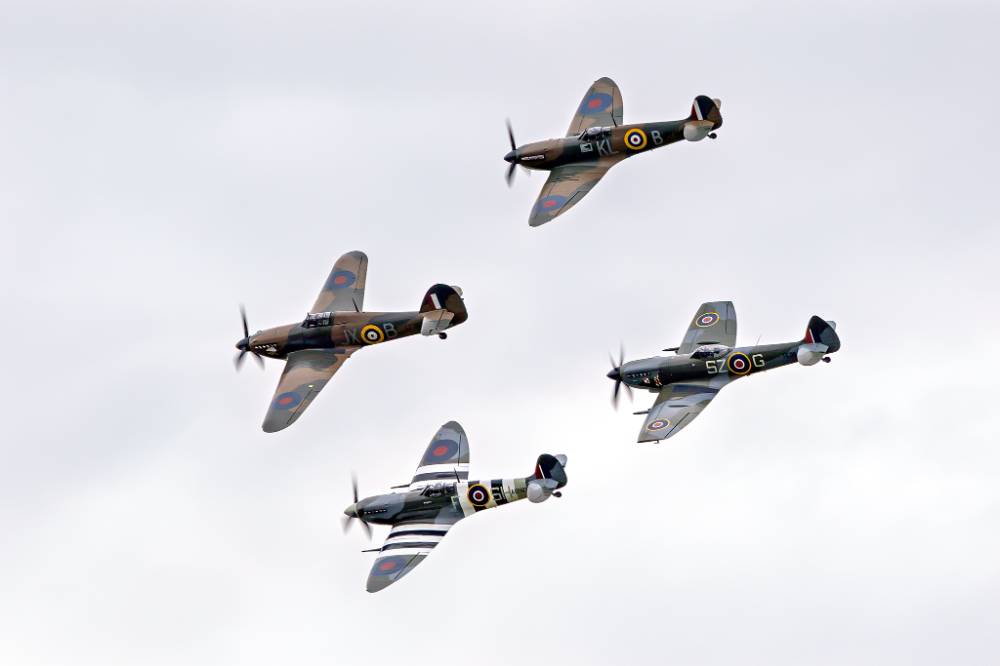
Image Courtesy of Mike Gauckwin
As the RAF was about to retire the very last Spitfires from service in the late 1950s, one man had the foresight to see that there would be a great benefit from keeping a small number of these iconic aircraft airworthy to carry out flypasts at ceremonial events as a living memorial to RAF personnel who had made the ultimate sacrifice in defence of their country.
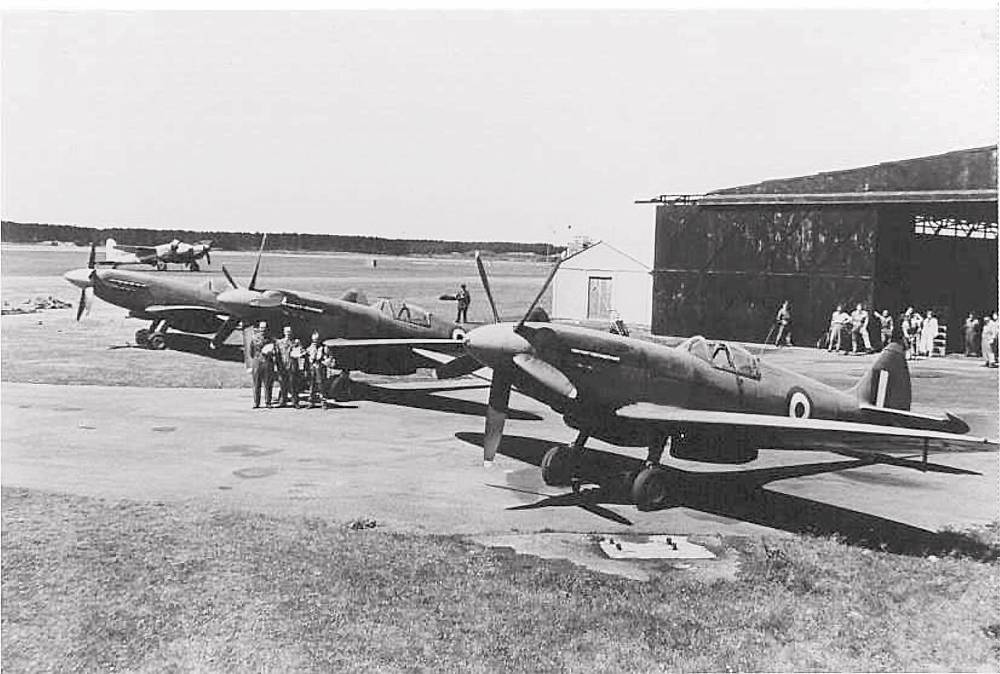
Image Crown Copyright
That man was Wing Commander Peter Thompson, the then Station Commander at one of the most famous Battle of Britain airfields – Biggin Hill. Thompson already had one aircraft at his disposal for just such occasions – Hawker Hurricane IIc LF363 which was operated by Biggin’s Station Flight. In 1957, the RAF’s last three airworthy examples of the Supermarine Spitfire, which were flying with the civilian-operated Temperature and Humidity (THUM) Flight at Woodvale airfield near Liverpool, were due to be withdrawn from service. The three Spitfire PR.XIXs (PM631, PS853 and PS915) had been making daily meteorological reconnaissance flights but, with spares becoming ever more difficult to source, a decision was taken to replace them with Mosquitos.
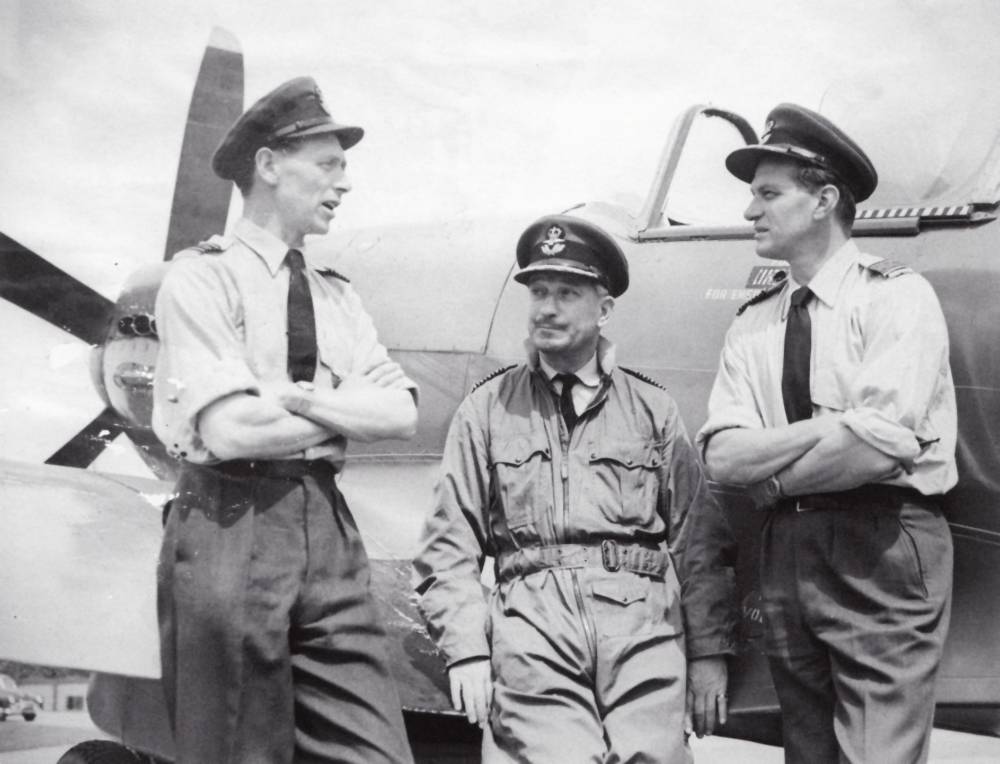
Image Crown Copyright
On 10 June 1957, the final ascent (and the very last RAF operational Spitfire flight) was made by PS853. Two days later, Woodvale attempted to despatch the aircraft to Duxford where they would be serviced and have specialist equipment removed, but all three would make it no further than the airfield boundary; PS915’s engine would not start, PM631 did make it into the air but the pilot had to return immediately after a radio failure and PS853 took off, suffered its own engine problem, landed, ran off the runway and tipped onto its nose. Repairs to the errant aircraft were quickly carried out and two days later, PM631 and PS915 departed for Duxford with PS853 following on the 26th.
With the aircraft readied for the new roles as ‘exhibition aircraft’, they were then flown to Biggin Hill on 11 July. Thankfully, there was no repeat of the events at Woodvale a month earlier and the formation - Group Captain JE ‘Johnnie’ Johnson leading in PS853 with Group Captain James Rankin and Wing Commander Thompson flying PM631 and PS915 respectively – headed south, escorted at times by Hunters of 41 Squadron and Javelins of 46 Squadron.
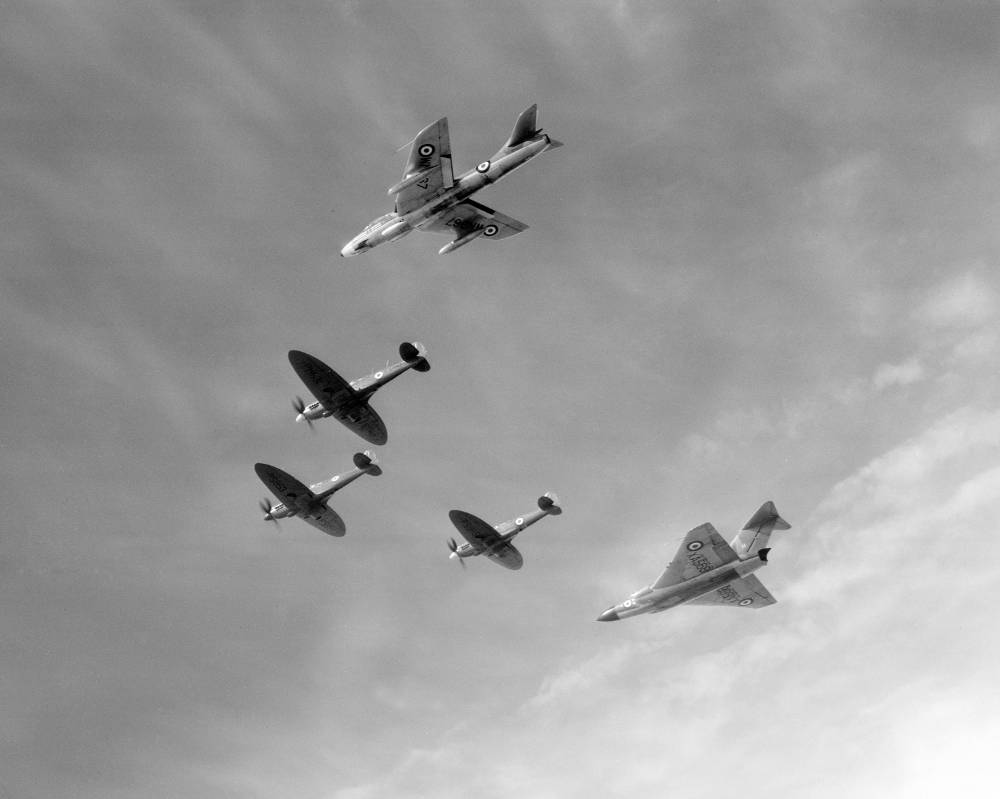
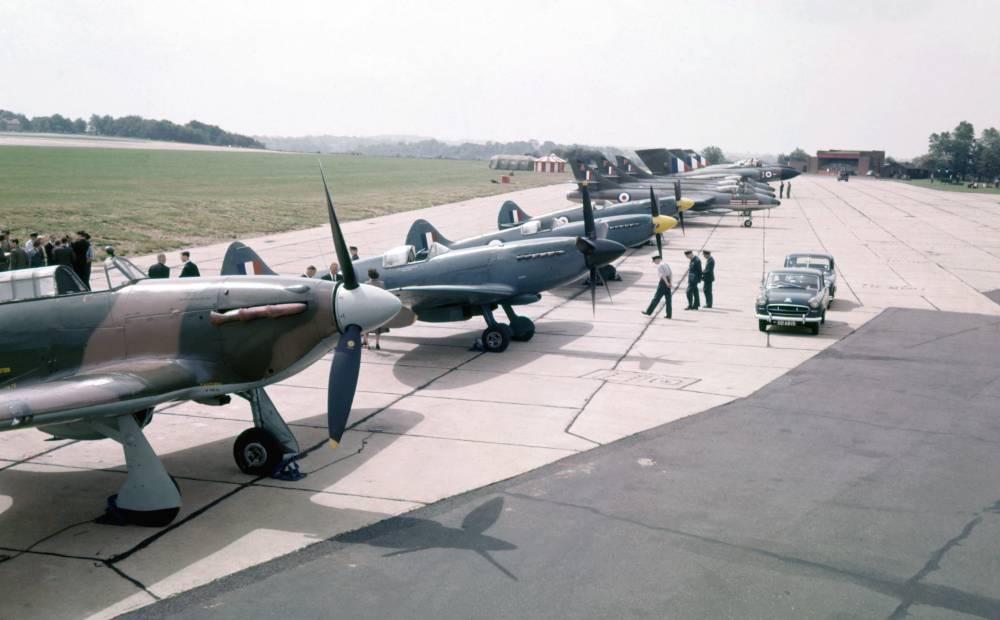
Image Crown Copyright
After landing shortly before lunch, they were met by Air Marshal Sir Thomas Pike, Air Officer Commanding-in-Chief Fighter Command, who, in an announcement to the waiting press, revealed the creation of the RAF Historic Aircraft Flight. Despite the high-level backing, the Flight (which also included LF363 on its strength) would be operated on a voluntary basis. Engineering support was placed in the hands of a small team led by Squadron Leader EH Sowden, Officer Commanding Engineering Wing, who had experience with Hurricanes and Spitfires in the Second World War.
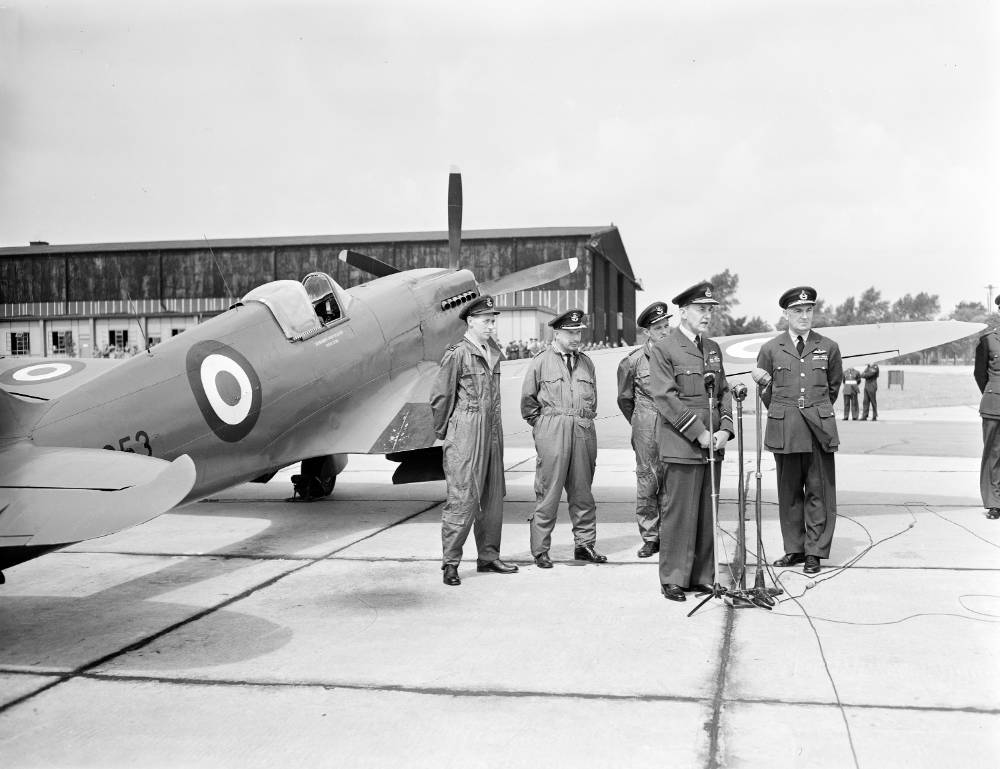
Image Crown Copyright
Sowden and his team inspected the airframes at hand and PS915 was immediately grounded due to its poor condition placed on display at West Malling; PS853 would later suffer the same fate and used as a gate guard at West Raynham. The next aircraft join the fledgling flight were three Mark XVIs – SL574, TE330 and TE476. None of these were airworthy but, having been overhauled recently, work began on TE330 to allow it to lead that year’s Battle of Britain parade flypast in September. A team of eight engineers worked on the aircraft, and having completed its air test on 8 September, TE330 joined LF363 over crowds gathered outside Westminster Abbey seven days later.
Renamed the Battle of Britain Flight in February 1958, the airworthy fleet was expanded with the completion of work on SL574 and in the following month the Flight moved to another former Battle of Britain airfield, North Weald, following the closure of Biggin Hill. Just three months later, however, it was announced that North Weald would itself be closing and the Flight moved again, this time to Martlesham Heath in Suffolk.
Things did not progress well over the following years. In 1958, both SL574 and TE478 would suffer damage in separate incidents and it was decided that September 1959 would be the final time the Flight’s aircraft would be allowed to fly over the Battle of Britain parade in London. As if the decision needed vindication, SL574 suffered an engine failure over the capital and its pilot, Air Vice Marshal HJ Maguire had to force-land the stricken Spitfire on a cricket ground in Bromley. Both aircraft were not returned to flight and disposed of, becoming gate guards (and, ultimately, shipped to museums in the United States). Another of the Flight’s aircraft to head across the North Atlantic was TE330 which was gifted to the US Air Force Academy at Colorado Springs in May 1958.
Now reduced to just two airworthy aircraft, LF363 and PM631, the Flight moved to Horsham St Faith (now Norwich Airport) in 1961 and again in 1963, to nearby Coltishall where it would remain for over a dozen years.
While at Coltishall, the fleet of aircraft began to expand with the additional of a number of new airframes. First to arrive (in April 1964) was PS853 which, following its stint on display at West Raynham had been returned to the air and issued to the Central Flying Establishment Communication Flight in 1962. Next was AB910, a Spitfire Vb which had seen action over the beachhead on D-Day, which was presented by Vickers-Supermarine on 16 September 1965 having been flown in by Jeffrey Quill, the renowned Spitfire test pilot, on his last ever flight.
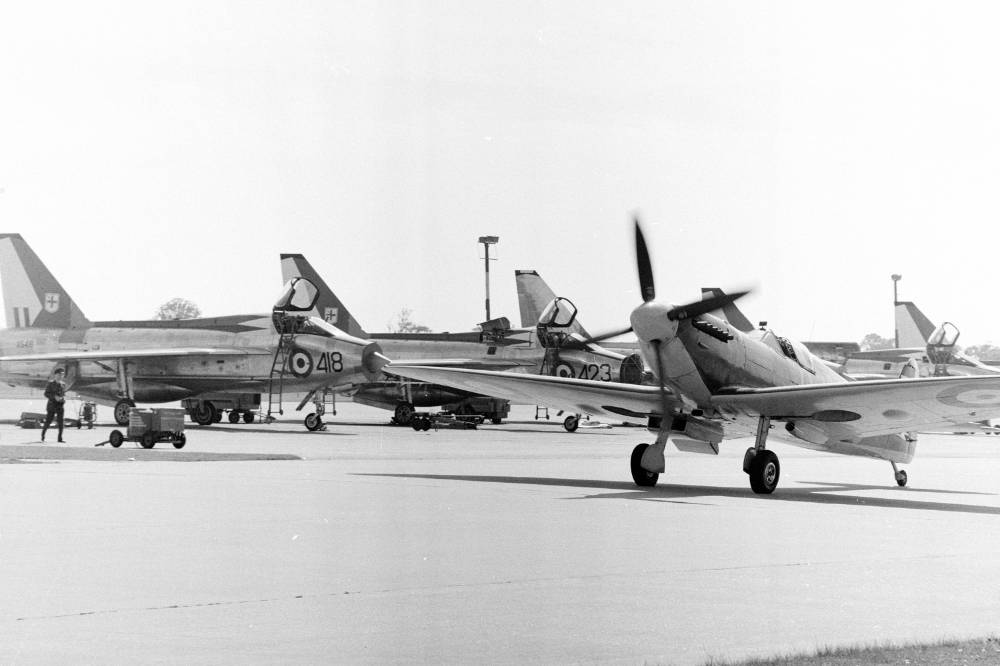
Image Crown Copyright
In 1969, a blockbuster film about the Battle of Britain was released, featuring such stars as Michael Caine, Christopher Plummer and Lawrence Olivier. A former RAF group captain, Hamish Mahaddie, was tasked with sourcing aircraft for the film and in the end 27 Spitfires and 6 Hurricanes would feature in the flying sequences. Among them were those of the Battle of Britain Flight – even though they were later models not developed until later in the Second World War. Modifications to the Spitfires and new markings were applied to make them more representative of the Mark Is and IIs used in 1940. To make it look like more aircraft were actually used, each bore two or three different identities.
The next addition to the Flight’s numbers was an aircraft which had actually taken part in the Battle of Britain and greatly benefitted from its involvement in the film, Spitfire IIa P7350. Having survived through to the end of the War, it was sold as scrap but later donated to the station museum at Colerne, Wiltshire, where it remained until 1967 when it was selected to be one of the flying aircraft used in the film. With shooting complete, it was then presented to the Battle of Britain Flight on 5 November 1968. It remains the only airworthy Spitfire in the World to have taken part in the air battle.
Involvement in the film would, however, took its toll on the Flight’s aircraft. The number of hours flown in 1968 increased to more than 260 (rather than the more customary 100) as the Flight had its air show commitments as well as film flying to account for. LF363 required a complete replacement of its fabric which was carried out during its winter servicing.
An increase in public awareness brought about the biggest change to the Flight’s organisation in 1969 when it was established on a formal basis with additional full time ground crew posted in to maintain the aircraft. A change in name to the Battle of Britain Memorial Flight also took place on 1st June.
A second Hurricane II, PZ865, arrived in March 1972. thanks to a certain amount of skulduggery on the part of Hawker’s Chief Test Pilot, Duncan Simpson, which lead to the donation of the aircraft to the BBMF at Coltishall in March 1972. Simpson believed that the aircraft, unlike other Hawker-owned aircraft which had been promised to the then recently completed RAF Museum at Hendon, should be kept in the air, and flew the aircraft unannounced to the Norfolk station before handing it over to a Flight Sergeant without ceremony.
One more major addition would follow at the end of the following year – the world’s only airworthy (at that time) Avro Lancaster bomber, PA474. Following its retirement as a testbed in 1964, Wing Commander MA D’Arcy, OC 44 Squadron at Waddington, requested that PA474 be transferred to his squadron where it would be maintained in flying condition. His application was accepted and over the next eight years, aircrew normally used to operate Vulcans, would fly the Lancaster at air shows and ceremonial events. The latter included the parade to mark the amalgamation of Bomber and Fighter Commands into Strike Command in April 1968, an event which was preceded with a formation featuring PA474 in the company of LF363 and AB910 in what would be the first of countless such appearances in later years. By 1973, maintaining the Lancaster was becoming more difficult and the aircraft was transferred to the BBMF where it could receive the required level of care.
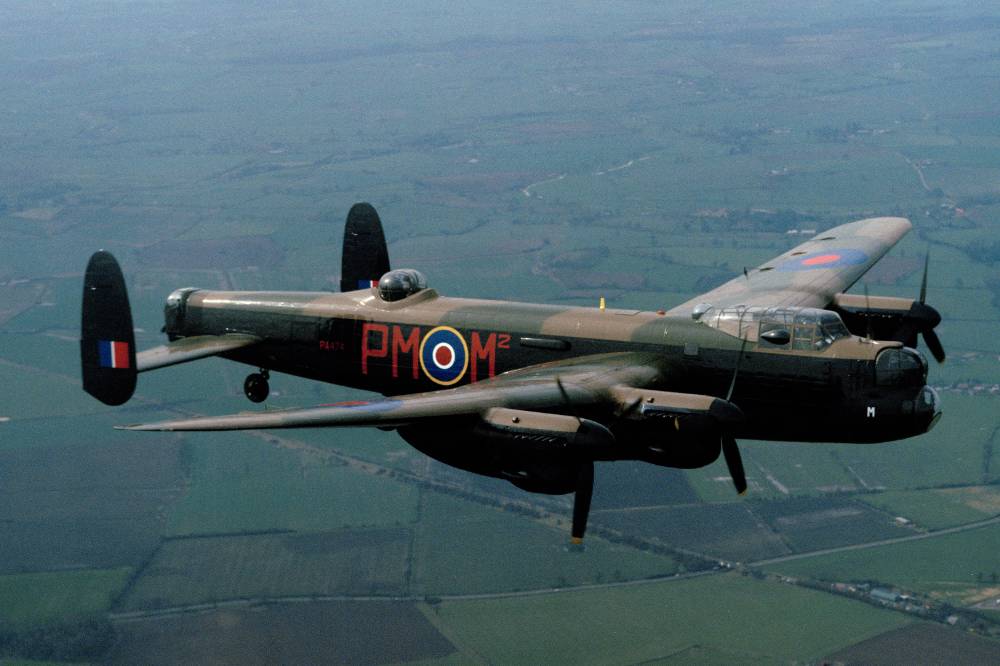
Image Crown Copyright
In 1976, with the introduction of the Jaguar fighter-bomber at Coltishall, the Flight moved to its current home at RAF Coningsby.
These aircraft would be the principal display assets for over two decades, but three additional aircraft would join the Flight in the 1980s in support roles. In April 1983, a pair of Chipmunk trainers (WK518 and WP855) were added to provide training on ‘tail-dragger’ aircraft as well as crew ferrying. They were joined two years later by Devon C.2 VP981 which supported displays flown further from home. In 1993, ZA947, a Dakota C.3 was taken on charge after a campaign by senior Army officers to preserve the aircraft (which had been declared as surplus by the Defence Research Agency at Farnborough) to take part in the forthcoming D-Day and VE-Day (Victory in Europe Day) 50th anniversary celebrations in 1994 and 1995. The Dakota replaced the Devon in the support role and was also a useful training aid when converting crews for the Lancaster because of its size and ‘tail-dragger’ configuration.
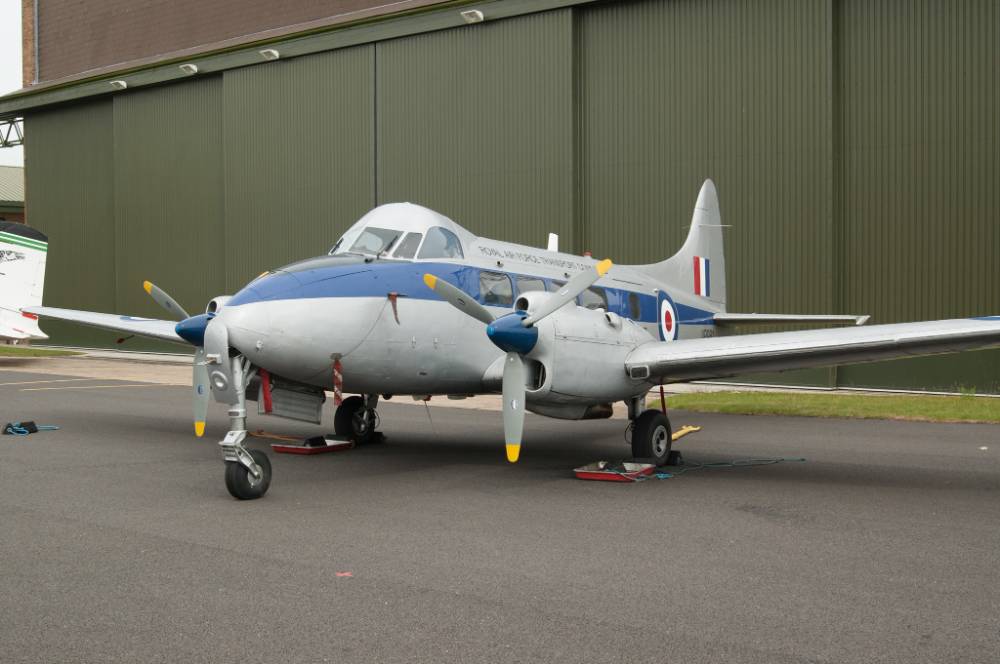
Image Courtesy of Jim Baker
Since its inception, flight safety has been a paramount consideration for BBMF’s personnel. Thankfully, the number of incidents involving such valuable aircraft remains small, but two incidents in particular have seen significant damage incurred by their aircraft. The first was on 21 August 1978 at an air show at Bex in Switzerland when AB910 collided with a Harvard while attempting to take off. The two aircraft became locked together and the Harvard pushed back some distance. The Spitfire’s engine bulkhead was damaged and rear fuselage buckled and repairs took 3 years to complete. (AB910 has lived something of a charmed life, suffering damage on four occasions during the Second World War plus a further four while with BBMF. Also notable is a flight which occurred on 13 July 1944 at Hibaldstow, Lincolnshire, when the aircraft took the air with an additional ‘passenger’. As was the practice on windy days, Leading Aircraftwoman Margaret Horton, a flight mechanic, was seated on the rear fuselage as the aircraft taxied out but, as would normally happen, the pilot failed to stop to allow her to alight before taking off and Margaret clung on for her life as Flight Lieutenant N Cox opened the throttle. Sensing the controls, a little sluggish, Cox landed immediately, only to exit his aircraft and see the terrified airwoman still holding on to the tail.)
More serious were the events of 11 September 1991. During a transit from Coningsby to Jersey, LF363’s engine started running rough and smoke began pouring from the Merlin exhaust stubs. The pilot, Flight Lieutenant Allan Martin, attempted to make a landing at Wittering but the engine lost power completely on approach and the right wing struck the ground. Despite having suffered a broke ankle in the landing, Martin was able to make good his escape from the now burning aircraft. Wittering’s fire crews managed to put the flames out but damage to the Hurricane was substantial. Repairs were authorised but with public funds at a premium, it was decided to partially fund the repairs by the sale of one of BBMF’s Spitfire’s XIX’s, PS853, to Rolls Royce. LF363 was completely rebuilt between 1994 and 1998 by Historic Flying at Duxford when the Hurricane re-joined the BBMF.
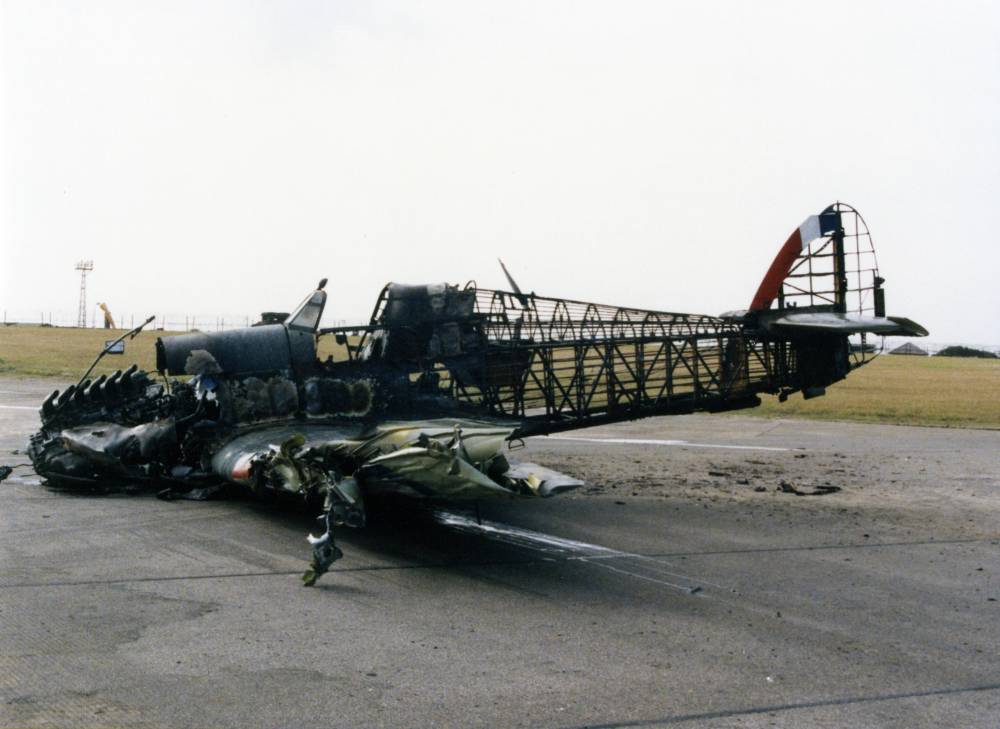
Image Crown Copyright
Before LF363 had returned to the Flight, its numbers of Spitfires had been increased following the delivery of MK356, a clipped-wing LF.IXe. Like AB910, the aircraft had seen action over the D-Day beaches (3 sorties being flown on 6 June with 443 Squadron RCAF) before being grounded and used as a gate guard. Subsequently stored at St Athan in South Wales, MK356 was selected to be made airworthy once again, and restoration began in 1992 in the hands of a small team of volunteers at the station who worked on the aircraft in their spare time. Finally, on 7 November 1997, MK356 took to the air for the first time since 1944 and it was flown to Coningsby a week later.
The last two aircraft delivered to the Flight arrived from Abingdon, Oxfordshire, in 1999. Two Spitfire XVIs – TB382 and TE311 – which had been used as travelling exhibits by the RAF Exhibition Flight were initially used for spares reclamation due to their poor condition. TB382 was subsequently struck-off but TE311 was retained and, in 2001, permission obtained to restore the distinctive aircraft with its low-back and teardrop canopy to airworthy condition. As with MK356, the restoration process was a laborious one – taking 10 years in total - as BBMF technicians could only work on the aircraft as other projects permitted and it wouldn’t be until 19 October 2012 that TE311 was airborne once again, albeit with a few post-flight teething problems to overcome.
The BBMF today consists of around 30 engineers (headed by a squadron leader and warrant officer) who are responsible for the upkeep of the Flight’s 12 priceless aircraft – 6 Spitfires, 2 Hurricanes, Lancaster, Dakota and 2 Chipmunks. – to ensure that they can continue to be seen in the air for many years to come. Remedial work generally takes place in the off-season (October-March) along with more in-depth periodic servicing. Between April and September, they support appearances across the country and on the Continent where trips could take several days. The engineering work of the Flight is also supported by accredited partners in industry who overhaul or manufacture key parts. Perhaps the most critical of these are the engines. Each of BBMF’s 17 Merlin or Griffon power plants has a 500-hour life, at which point they are replaced and sent away for an in-depth refurbishment and effectively zero-lifed.
Pilots and crews are all serving officers. Those chosen for the fighters are drawn from the Typhoon squadrons based at Coningsby while the Lancaster and Dakota are put in the hands of personnel accustomed to operating multi-engine aircraft such as the Atlas or Hercules. The post of Officer Commanding is filled by a pilot experienced in the operation of BBMF and is a 3-year tour for the lucky individual chosen. A full-time adjutant allocates crews and aircraft for the display season, accommodating an average of around 100 displays and 800 flypasts per year while keeping an eye on the hours flown by individual airframes so that annual totals are not exceeded. These totals can increase in years where key anniversaries occur. In these years, special display routines and formations are approved and flown; the 70th and 75th anniversary of the Battle of Britain saw a Spitfire/Typhoon synchronised pair while the RAF Centenary brought about ‘Trenchard’ formation which featured the Dakota, Lancaster, both Hurricanes and three Spitfires.
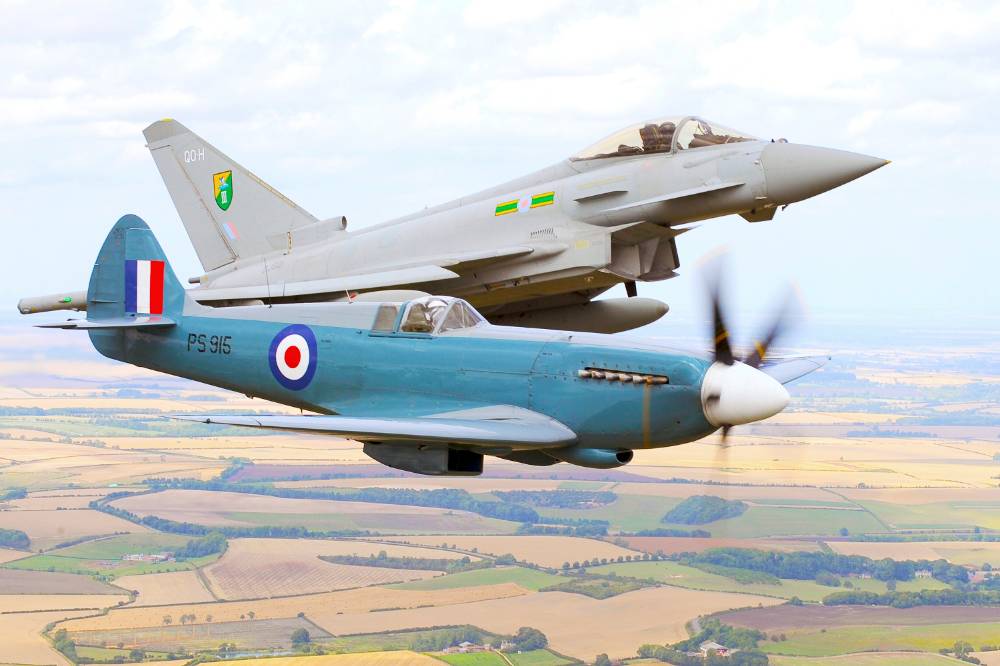
Image Crown Copyright
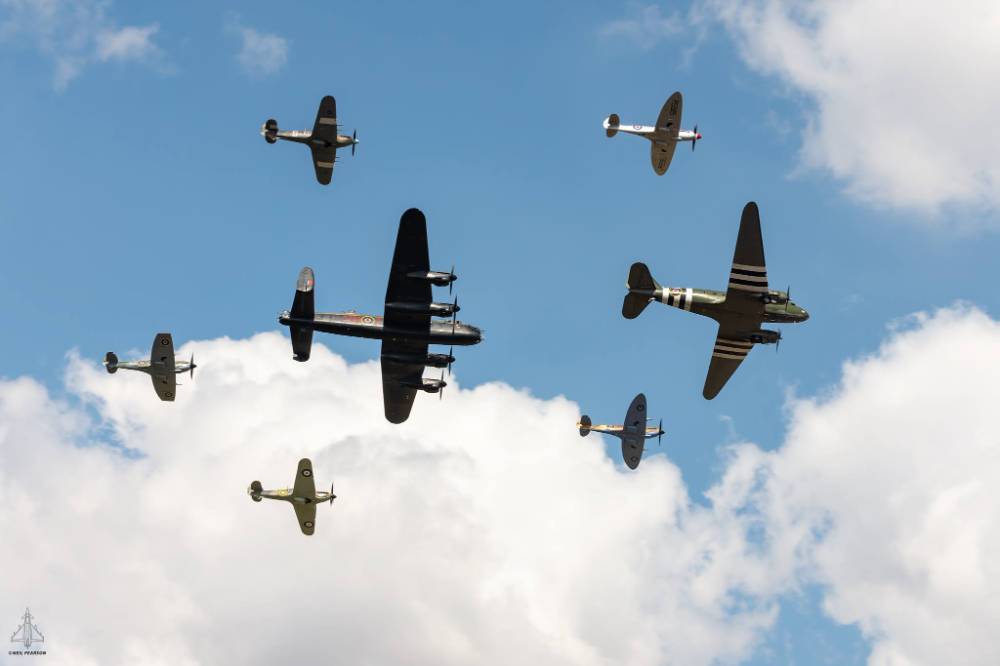
Image Courtesy of Neal Pearson
All of BBMF’s aircraft are periodically repainted in different squadron markings during major servicing, representing famous squadrons and individuals from the RAF’s past, the announcement of these changes are greatly anticipated by enthusiasts and a source of great pride to veterans alike. The latest aircraft to arrive back at RAF Coningsby is Hurricane PZ 865 painted in a night intruder scheme
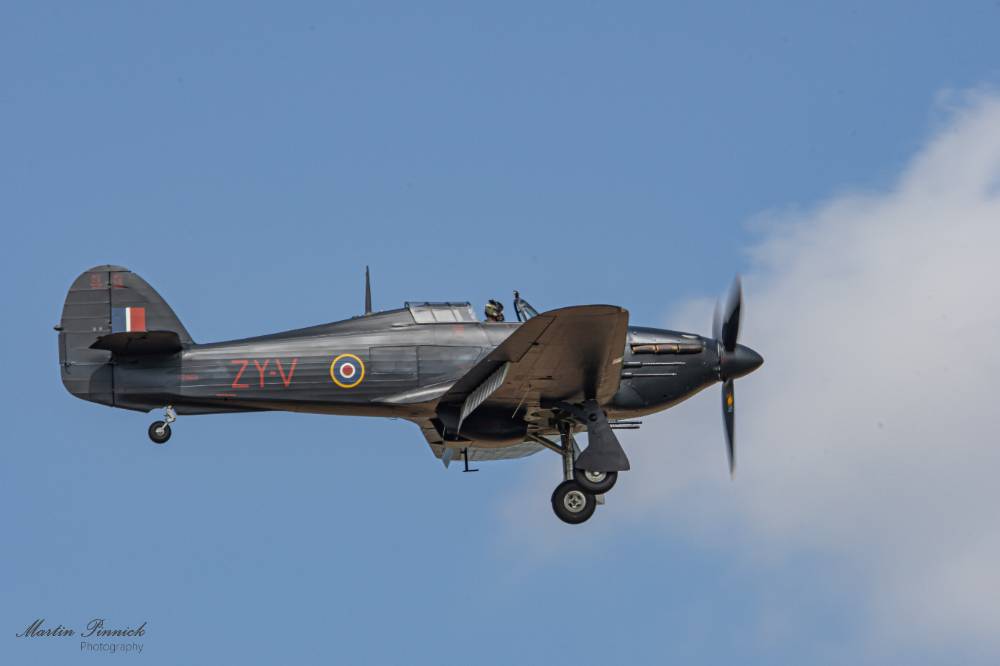
Image courtesy of Martin Pinnick